Serviços Personalizados
Journal
Artigo
Indicadores
-
 Citado por SciELO
Citado por SciELO -
 Acessos
Acessos
Links relacionados
-
 Similares em
SciELO
Similares em
SciELO
Compartilhar
Tourism & Management Studies
versão impressa ISSN 2182-8458
TMStudies no.7 Faro dez. 2011
Long-Term Forecasting of the Spa And Wellness Subsector of the Bulgarian Tourism Industry
Previsão de longo prazo do subsetor de SPA e bem-estar da indústria turística da Bulgária
Preslav Dimitrov
Associate Prof., South-West University "Neofit Rilski", Blagoevgrad, Bulgaria preslav.dimitrov@mail.bg
ABSTRACT
In the past twelve years Bulgaria has managed to capitalize on the good results achieved in certain subsectors of its tourism industry, such as the spa and wellness industry. The fluctuations in the international tourism markets due to the world economic crisis, however, still provoke hesitations for the investors in the Bulgarian tourism industry. This uncertainty and the fear of possible negative outcomes in Bulgaria’s spa and wellness tourism could be diminished if there are comparatively true long-term forecasts for what is to happen in the coming 10 or 12 years.
The present paper regards the application of some forecasting methods in the spa and wellness sub-sector of the Bulgarian tourism industry such as linear trend forecasting and double exponential forecasting (Holt’s method). A specially designed model for estimation of the weight coefficient needed for determining the size of the sector of the spa and wellness tourism in the time series of the available data and in the forecast values is presented. A time series and past period predictions have been constructed based on statistical records since 1964 in order to test the forecasting methods presented in the paper and to produce forecasts up to the year 2022.
KEYWORDS: Forecasting, Exponential Smoothing, Spa and Wellness Industry.
RESUMO
Nos últimos doze anos a Bulgária conseguiu capitalizar os bons resultados alcançados em alguns subsectores da sua indústria do turismo, como a indústria de SPA e bem-estar. As flutuações nos mercados internacionais de turismo devido à crise económica mundial, no entanto, ainda provocam a hesitação dos investidores na indústria do turismo búlgaro. Esta incerteza e o medo de possíveis resultados negativos no turismo de SPA e bem-estar da Bulgária poderiam ser diminuídos se houvesse, comparativamente, verdadeiras previsões de longo prazo para o que vai acontecer nos próximos 10 ou 12 anos
O presente trabalho refere-se à aplicação de alguns métodos de previsão no sub-setor de SPA e bemestar da indústria do turismo búlgara como a previsão de tendência linear e previsão exponencial dupla (método de Holt). É apresentado um modelo especialmente concebido para a estimativa do coeficiente de peso necessário para determinar o tamanho do setor do SPA e do turismo de bem-estar na série temporal dos dados disponíveis e nos valores de previsão. Foram construídas séries temporais e previsões de período passado com base em registos estatísticos desde 1964, a fim de testar os métodos de previsão apresentados no artigo e produzir previsões até ao ano de 2022.
PALAVRAS-CHAVE: Previsão, Suavização Exponencial, Indústria de SPA e Bem-Estar.
1. INTRODUCTION
In the past twelve years the Bulgarian tourism industry reached a stage of a bubbling increase, which was followed by the negative impact of the world financial and economic crisis. Bulgaria however succeeded to capitalize on the good results achieved in certain subsectors of its tourism industry, such as the spa and well industry, and has recently lined up in the top three suppliers of spa and wellness services in Europe, alongside with France and Romania. As it was estimated in 2008, France, Bulgaria and France jointly provided some 60% of the supply in the spa and wellness subsector of the tourism industry in Europe (Pugin, Pachoud, Kaneva, Dimitrov et al., 2010).
The fluctuations on the international tourism markets emitting tourists to Bulgaria, which were felt as a disturbing aftermath of the economic crisis, still provoke hesitations in the investment decisions of a significant part of the investors in the Bulgarian tourism industry (banks, investment funds, and holding companies). This uncertainty and the fear of possible negative outcomes could be diminished to some extent if there are convincing and comparatively true long-term forecasts for what is to happen in the coming 10 or 12 year. And this refers also to the best performing sub-sectors of the Bulgarian tourism, i.e. the spa and wellness tourism.
Graphic 1: Bulgaria's geograpic situation in the region of South-East Eurpoe
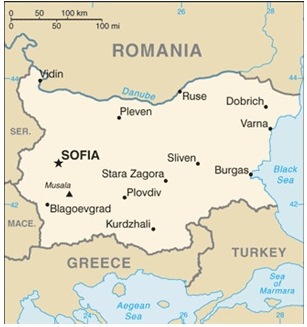
2. OBJECTIVES
The task of creating a forecast model for the long-term development of a certain subsector of the tourism industry, such as the spa and wellness tourism in Bulgaria, meets with the solving of five major problems:
(i) Finding of a suitable general indicator, on the basis of which to build the long-term forecasts (the forecast for periods longer than 5 years);
(ii)Selecting and using of suitable forecasting techniques;
(iii)Calculating of long-term forecasts for the value of the above-mentioned general indicator (up to the year 2022);
(iv)Comparing the results of the forecast techniques (the forecast models) on the basis of the errors in the forecasts.
(v)Estimating the size of the Bulgarian spa and wellness tourism in certain terms, so that the forecast(s) of the above-mentioned general indicator could be particularized especially for this sub-sector.
3. METHODOLOGY AND MAIN RESULTS
The difficulties in finding of a general suitable indicator, on the basis of which to make the forecast, come mainly from the reliability and the sustainability of the existing data for the separate types of indicators for tourism demand, especially in terms of time.
A greater part of the existing indicators are inconsistent in time and they lack enough data which would allow the building of sufficiently long time series.
Here one could refer to certain indicators such as the "volume of the tourism receipts", which was calculated for different periods of time in different currencies – non-denominated Bulgarian leva, US dollars, German marks and Euros. At the same time, the indicator "number of tourism arrivals", respectively "number of foreign tourists", as per the definition of the United Nations World Tourism Organization, was introduced and implemented in the Bulgarian statistical system in the end of 1990s.
The sole indicator which allows a comparatively long and sustainable time series to be built is the indicator "number of foreign visitors with recreation and holiday aims", which continues to be recorded by both the former State Tourism Agency (now part of Bulgaria’s Ministry of Economy, Energy and Tourism) and the Bulgarian National Statistic Institute as a part of the indicator "number of the foreign citizens visiting Bulgaria with tourism aims".
Taking into account the annual data available for the indicator "number of foreign visitors with recreation and holiday aims", one can build a time series of 47 time periods (Graphic 2 and Graphic 3) – from 1964 to the last year with recorded value 2010.
Graphic 2: Number of forein visitors in Bulgaria with recreation and holiday aims for the time period 1964-2010 (in thousends)
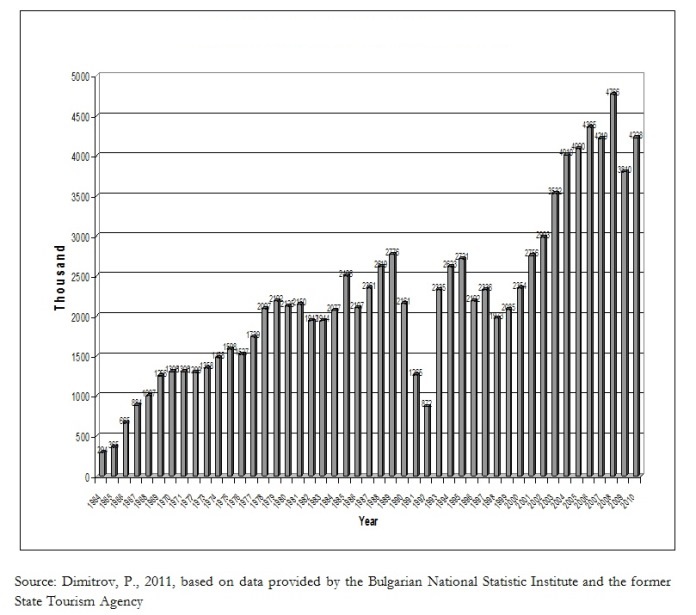
Graphic 3: The actually observed value of the times series of the foreign visitors in Bulgaria with recreation and holiday aims and the trend line calculated by use of SPSS (c)
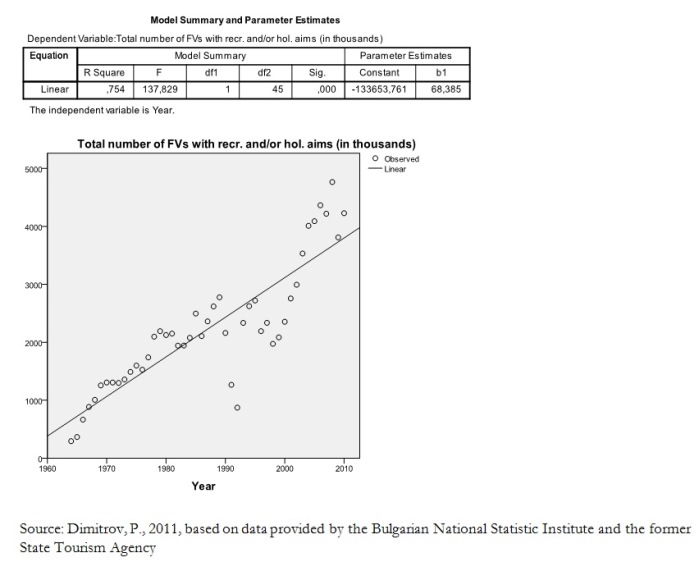
As for the selection and usage of a suitable forecasting technique, by applying of statistical software, such as SPSS ©, it is possible quite easy to draw both the development curve of the actually observed values of the indicator and the linear trend line.
The trend line could be notated by the following line equation:
(1)  ,
,
Where:
 is the trend value of the indicator "number of foreign visitors with recreation and holiday aims" as a linear function of time measured in years;
is the trend value of the indicator "number of foreign visitors with recreation and holiday aims" as a linear function of time measured in years;
 –the value of the interception (segment) point between the line (the trend line) and the ordinate (the Y-axis) of the coordinate system;
–the value of the interception (segment) point between the line (the trend line) and the ordinate (the Y-axis) of the coordinate system;
 – the value of the angle coefficient of the line (trend line);
– the value of the angle coefficient of the line (trend line);
t – time in terms of years.
The values of b0 and b1, which define in full the line (the trend line), are calculated by the help of the least squares method and in this particular case for this task the SPSS software product was applied. As it becomes evident from Chart 4, the values of b0 and b1 are "–133653.761" and "68.385" respectfully and thus the trend line equation achieves the following notation:
(2) 
The value of b0 should not make any surprise as the ordinate (the Y-axis) on Graphic 3 just for convenience does not intercept the abscissa (the X-axis) at its value "0" point.
Equation (2) could be used for a long-term forecasting of the regarded market situation indicator. The extent of the error, however, if this method is applied for already past time periods, such as the past twenty years, is quite big. This is also obvious from Graphic 3.
In the regarded herein time series of the indicator "number of foreign visitors with recreation and holidays aims", in which a definite linear trend of increase could be distinguished, one could apply also the method of double exponential smoothing in the presence of a linear trend, known as the Holt’s method. The mathematical notation of this method is as follows:
The smoothing of the level (the base) – "L":
(3) 

The smoothing of the trend – "Т":
(4) 

The achieving of the final forecast "Ft+m" for "t+m" periods ahead in the future:
(5)  ,
,
Where:
„α" and „β" are the smoothing constants for the level and the trend respectfully which could take values between 0 and 1.
There are also other possible methods for long-term forecasting through the use of the exponential smoothing, however, here they are practically inapplicable either due the lack of seasonality, or because of the presence of a trend in the regarded time series. In the number of these methods comes also the method of the single exponential smoothing, which is unsuitable for long-term forecasting because of the very same presence of a trend in the time series.
In this situation, it would be useful if the selected method for forecasting through exponential smoothing – the method of the double exponential smoothing (the Holt’s method) is tested in different values of the smoothing constants „α" and „β" in order to minimize the forecast error. One of the criteria for this minimizing could be the mean absolute percentage of error (MAPE). For the purpose of visualization of the results from the different forecast methods for past and future periods, as well as the extent of achieved error (in comparison of the forecast values with the actually observed ones for the past periods of time), these results are presented in table and graphic form in Table 1, Graphic 4 and Graphic 5. As it is obvious from the table and the both graphics, the existing statistical software products could be used for defining of an optimal best-fit forecast model, i.e. for defining of the optimal values of the smoothing constants (used for calculations in column VII of Table 1 and for plotting the black dotted forecast curve in Graphic 4 and the curve in the Graphic 5). Of course, the inherent capacities of the statistical software products in this regard should not be overestimated and over-praised.
Graphic 4: Plotting of the results from the miscellaneous forecast methods for past and future time periods
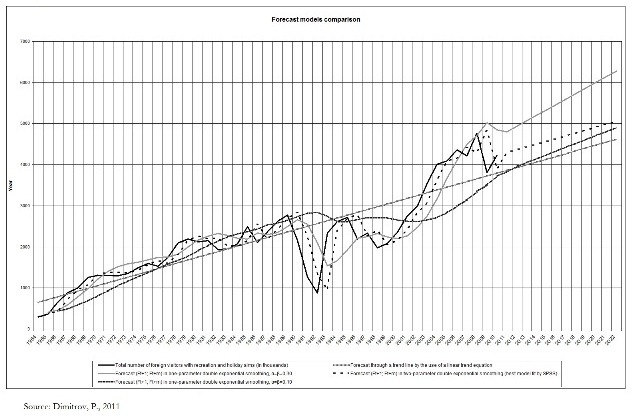
Graphic 5: Double exponential smoothing trough SPSS- mest-fit regard to the mean absolute percentage of error (MAPE)
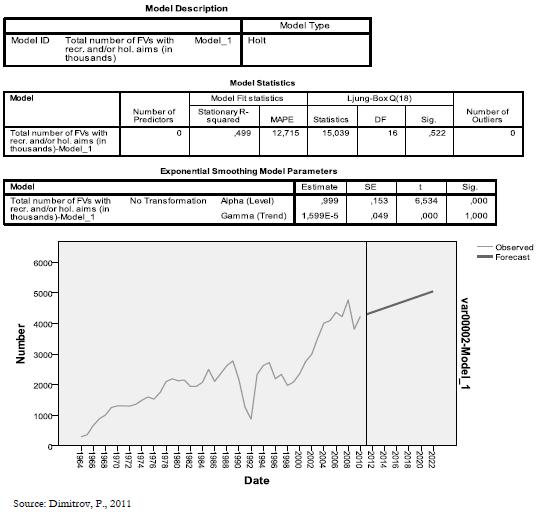
Table 1: Calculating of long-term forecasts - trough the linear tend equation and miscellaneous variation of the double exponential smoothing (Holt's Method)
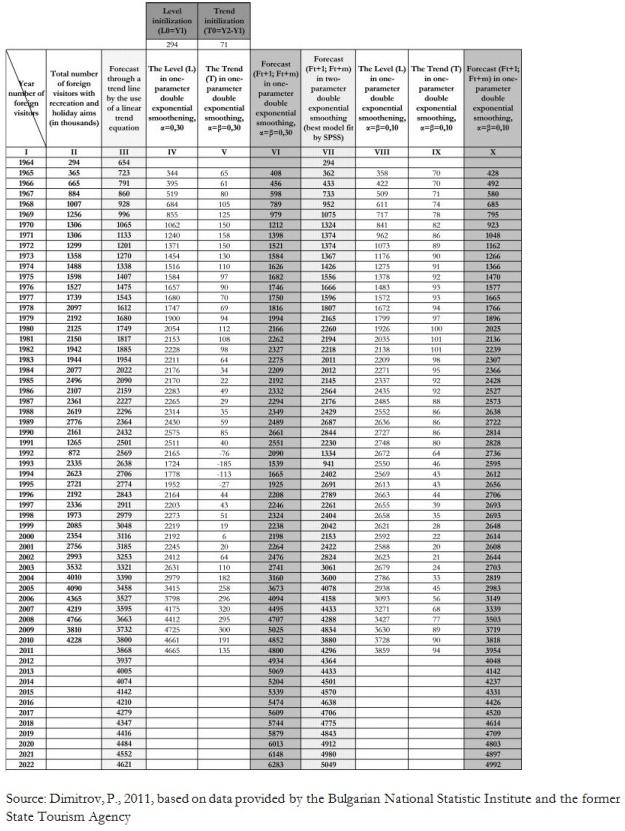
Table 1, Graphic 4 and 5 provide also a solution for the third and the fourth task set in the present paper, i.e. "(iii) Calculating of long-term forecasts for the value of the above-mentioned general indicator (up to the year 2022)"; and iv "Comparing the results of the forecast techniques (the forecast models) on the basis of the errors in the forecasts".
Based on the results in Table 1 and Graphic 4, one can outline three major types of forecasts for the number of the foreign visitors with recreation and holiday aims for 2022, as follows:
- A pessimistic forecast (the forecast with the lowest value) – calculated by the linear trend equation method:
4 621 000 foreign visitors;
- The forecast (calculated by the use of SPSS) with the lowest mean absolute percentage of error(MAPE) – calculated by the method of the double exponential smoothing with α=0.999 andβ=1.599x10-5:
5 049 000 foreign visitors;
- The most optimistic forecast (the forecast with highest value) – calculated by the method of the one-parameter double exponential smoothing with α=β=0.30:
6 283 000 foreign visitors.
All these forecasts, as well as the forecasts presented in Table 1 and Graphic 4, have one major disadvantage – they are produced for the general indicator "number of foreign visitors in Bulgaria with recreation and holiday aims", which means that it refers to the whole of Bulgarian tourism industry and not to the sub-sector of spa and wellness tourism. In order to overcome this disadvantage, a certain modification is needed.
One way of doing so is by the use of a weight coefficient which shall indicate the share of the foreign visitors with intention to practice spa and wellness tourism. Or, as it has been mentioned in the initial part of this paper, an estimation of the sizes of the Bulgarian spa and wellness tourism is needed to make the above general indicator more particularized (task v). Thus, equation (5) can be modified into equation (6), as follows:
(6)  ,
,
Where:
FswtT+1 is the forecast for time period "T+1" for the number of foreign visitors with cultural tourism aims;
Kswt is the coefficient of the share of foreign visitors with spa and wellness tourism aims;
Lt – the level (the base);
Tt – the trend;
t – time expressed in terms of years.
m – the number of periods ahead in the future for the forecast in concern.
Neither the Bulgarian National Statistical Institute (NSI), nor the Bulgarian State Agency on Tourism, nor any other Bulgarian government institution keeps a regular statistical record of the foreign visitors with spa and wellness tourism aims. However, there are six consequent surveys on the foreign visitors in both the winter and conducted by the market research companies "NOEMA", MBMD and the "Sinesta" Consortium in Bulgaria. These six surveys, though based on samples of approximately 3000 foreign citizens visiting Bulgaria, provide two sets of important figures: (i) a percentage shares of the foreign visitors practicing spa and wellness activities in the months of the winter tourism season and (ii) a percentage share of the foreign visitor practicing spa and wellness activities in the months of the summer tourism season. Based on these two sets of figures, a model for calculating the Kswt (the coefficient of the share of foreign visitors with spa and wellness tourism aims) can be built (Table 2).
Table 2: K

The model, presented in Table 2, have of course many weak points. The first consideration in this regard is the fact that the coefficient Kswt is calculated on the assumption that it will remain constant in value throughout all the forecast periods. The only reason for accepting of such a rough assumption is the scarcity of statistical records on which to build a separate model for the development of the coefficient in the course of time. The second week point is that the coefficient Kswt is calculated on the basis of data received from sample surveys, which on the other hand are conducted by different companies and thus there are: (i) probability errors in the data collected; and (ii) some, though not quite big, differences in the size of the samples and in the methodologies of surveys. The third week point comes in the fact that due to the already mentioned lack of previous data only three consequent years have been used for the calculation of the coefficient Kswt. However, this is yet a try to overcome the entire lack of regular statistic data for the spa and wellness tourism in Bulgaria.
Having calculated the value of Kswt and using equation (6), as well as the data in Graphic 1 and 2 and Table 1, the forecasts of the number of the foreign visitors with spa and wellness tourism aims to Bulgaria for 2022 can be easily made. An even simpler way to do some of the necessary calculations is to multiply the already presented pessimistic, most optimistic and lowest MAPE level forecasts for the general indicator "number of foreign visitors with recreation and holiday aims" by the decimal value of Kswt, i.e. 0.2645, as follows:
· The pessimistic forecast for 2022 (the forecast with the lowest value) – calculated by the linear trend equation method:
FswtT+1 = 0.2645 x 4 621 000 = 1222 255 foreign visitors with spa and wellness aims;
· The forecast (calculated by the use of SPSS) with the lowest mean absolute percentage of error (MAPE) – calculated by the method of the double exponential smoothing with α=0.999 and β=1.599x10-5:
FswtT+1 = 0.2645 x 5 049 000 = 1 335 461 foreign visitors with spa and wellness aims;
· The most optimistic forecast (the forecast with highest value) – calculated by the method of the one-parameter double exponential smoothing with α=β=0.30:
FswtT+1 = 0.2645 x 6 283 000 = 1 661 853 foreign visitors.
4. CONCLUSIONS
The presented pessimistic, most optimistic and lowest MAPE level forecasts for the number of foreign visitors in Bulgaria with aims to practice spa and wellness tourism suggest that by 2022 it will vary roughly between 1 million 222 thousand and 1 million 662 thousand. Thus the steady growth of the Bulgarian spa and wellness tourism industry will continue with the presence of certain fluctuations which however will not endanger the positive long-term investment decisions in this subsector.
The presented in the paper forecasting technology, though having many shortcomings, could be applied also for other countries, which have unsteady and insufficient statistical records on the spa and wellness tourism. The main precondition for using this forecasting technology is to have a sustainable time series of a general tourism indicator such as "number of foreign visitors" and at least some clue about the size, the impact of the cultural tourism on this very same indicator. This clue could be produced out either of a market research, or as a by-product of another type of economic study.
BIBLIOGRAPHY
DIMITROV, P. (2010), "Short-run forecasting of tourism arrivals in separate sectors of Bulgarian tourism industry", International Scientific Conference "Alternatives for Development of the Modern Tourism, The Proceedings Book, 378-389. [ Links ]
HANKE, E., REITSCH, A. (1989), Business Forecasting, 3rd ed., Allyn&Bacon, Boston, USA. [ Links ]
HYNDMAN, R. J., KOEHLER, A. B., KEITH ORD, J., SNYDER R. D. (2008), Forecasting with Exponential Smoothing – The State Space Approach, Berlin, Germany, 14-19. [ Links ]
NATIONAL STATISTICAL INSTITUTE (2011), Statistical Yearbooks of the People’s Republic of Bulgaria for the period 1964-1989, available by request through http://www.nsi.bg.
NATIONAL STATISTICAL INSTITUTE (2011), Statistical Yearbooks of the Republic of Bulgaria for the period 19901999, available by request through http://www.nsi.bg. [ Links ]
PUGIN, J., PACHOUD, J.-N., KANEVA, T., DIMITROV P., ET AL. (2010), Synthèse européenne des états des lieux des besoins de professionnalisation des agents de soin thermal en Bulgarie, France et Roumanie, Project « Création d’une Certification Européenne d’agent de soin thermal (THERM) » financé par la Programme "Leonardo da Vinci" de l’UE, http://www.projettherm.eu/download/fr/1_EU_fr.pdf.
STATE AGENCY ON TOURISM (IN LIQUIDATION) (2011), Surveys and Analyses,http://www.tourism.government.bg/bg/stat.php?menuid=3&id=13. [ Links ]
Submitted: 26.08.2011
Accepted: 18.10.2011













